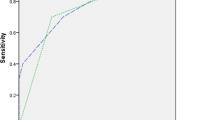Abstract
Relapse rates of surgically treated clubfeet are about 25%. We reviewed 43 patients (57 feet) treated for relapsed clubfoot deformity between 1992 and 2001 in our department. The average age of the patients at the time of revision surgery was 5.1 years, the mean follow-up was 6.6 years. Surgical therapy was performed using an algorithm according to age groups. The mean Atar score at follow-up was 77 points, representing a good outcome. Out of 57 feet, 20 (35%) were rated excellent, 24 (42%) good, 5 (9%) fair, and 8 (14%) poor. The number of previous surgical interventions had no influence on the outcome. Using an age related surgical algorithm, good postoperative results could be achieved in most of our patients, thus improving their functional situation. This emphasises the usefulness of the proposed algorithm in the difficult situation of recurrent clubfoot, while thorough analysis of the underlying deformity remains essential.
Résumé
Les récidives après traitement chirurgical des pieds bots sont relativement fréquentes aux alentours de 25%. Nous avons vu 43 patients (57 pieds) traités pour récidive de la déformation entre 1992 et 2001. L’âge moyen des patients à la révision était de 5.1 ans, le suivi moyen de 6.6 ans. Le traitement chirurgical a été réalisé selon un algorithme prenant en compte l’âge. Le score moyen d’Atar a été de 77 points, avec une bonne évolution clinique. Sur 57 pieds, 20 (35%) ont été considérés comme excellents, 24 (42%) bons, 5 (9%) comme moyens et 8 (14%) comme mauvais. Le nombre d’interventions chirurgicales utilisé réalisées n’influence pas le devenir du pied. L’algorithme selon l’âge a été utilisé pour la plupart des patients de façon à améliorer le résultat fonctionnel. Ceci nous conforte dans l’utilisation de cet algorithme dans les situations difficiles de récidives de pieds bots. Malgré tout cela, l’analyse des déformations reste essentielle.



Similar content being viewed by others
References
Atar D, Grant AD, Silver L, Lehmann WB (1990) The use of tissue expander in clubfoot surgery. J Bone Jt Surg 72B:574–577
Atar B, Lehman WB, Grant AD, Strongwater AM (1992) Revision surgery in clubfeet. Clin Orthop 283:223–230
Bansal VP, Daniel J, Rai J (1988) Radiological assessment of clubfoot. Int Orthop 12:181–185
Fowler SB, Brooks AL, Parrish TF (1959) The cavo-varus foot. J Bone Jt Surg A 41:757–761
Gordon JE, Luhmann SJ, Dobbs MB, Szymanski DA, Rich M, Anderson DJ, Schoenecker PL (2003) Combined midfoot osteotomy for severe forefoot adductus. J Pediatr Orthop 23(1):74–78
Haasbeck JF, Zuker RM, Wright JG (1995) Free gracilis muscle transfer for coverage of severe foot deformities. J Pediatr Orthop 5:608–612
Herold HZ, Torok G (1973) Surgical correction of neglected clubfoot in the older child and adult. J Bone Jt Surg 55A:1385
Hofmann AA, Constantine RM, McBride GG, Coleman SS (1984) Osteotomy of the first cuneiform as treatment of residual adduction of the forepart of the foot in clubfoot. J Bone Jt Surg A 66:985–990
Kamath BJ, Bhardwaj P (2005) Local flap coverage following posteromedial release in clubfoot surgery in older children. Int Orthop 29:39–41
Kose N, Gunal I, Gokturk E, Seber S (1999) Treatment of severe clubfoot deformity by trans-midtarsal osteotomy. J Pediatr Orthop B 8:251–256
Lehman WB, Atar D, Bash J, Grant A, Feldmann D, Kissin Y, Gutman J, Lindsey J (1999) Results of complete soft tissue clubfoot release combined with calcaneocuboid fusion in the 4-year age group following failed clubfoot release. J Pediatr Orthop B 8:181–186
Lehman WB, Atar D, Grant AD, Strongwater AM (1994) Treatment of failed clubfoot surgery. J Pediatr Orthop B 3:168–170
Lincoln CR, Wood KE, Bugg EI (1976) Metatarsus varus corrected by open wedge osteotomy of the first cuneiform bone. Orthop Clin North Am 7:795–798
Lourenco AF, Dias LS, Zoellick DM, Sodre H (2001) Treatment of residual adduction deformity in clubfoot: the double osteotomy. J Pediatr Orthop 21(6):713–718
Mc Hale KA, Lenhart MK (1991) Treatment of residual clubfoot deformity—the “bean-shaped” foot—by opening wedge medial cuneiform osteotomy and closing wedge cuboid osteotomy. Clinical review and cadaver correlations. J Pediatr Orthop 11:374–381
Pohl M, Nicol RO (2003) Transcuneiform and opening wedge medial cuneiform osteotomy with closing wedge cuboid osteotomy in relapsed clubfoot. J Pediatr Orthop 23:70–73
Ponseti IV (2000) Clubfoot management. J Pediatr Orthop 20(6):699–700
Ponten B (1981) The fasciocutaneus flap. Its use in soft tissue defects of the lower leg. Br J Plast Surg 34:215
Pryor GA, Villar RN, Ronen A, Scott PM (1991) Seasonal variation in the incidence of congenital talipes equinovarus. J Bone Jt Surg B 73(4):632–634
Raab P, Krauspe R (1999) Das Klumpfußrezidiv. Der Orthopäde 28:110–116
Sambandam SN, Gul A (2006) Stress radiography in the assessment of residual deformity in clubfoot following postero-medial soft tissue release. Int Orthop 30:210–214
Schäfer D, Hefti F (2000) Combined cuboid/cuneiform osteotomy for correction of residual adductus deformity in idiopathic and secondary clubfeet. J Bone Jt Surg B 82:881–884
Simons GW (1977) Analytical radiography of club feet. J Bone Jt Surg B 59(4):485–489
Tarraf YN, Carroll NC (1992) Analysis of the components of residual deformity in clubfeet presenting for reoperation. J Pediatr Orthop 12:207–216
Vizkelety T, Szepesi K (1989) Reoperation in treatment of clubfoot. J Pediatr Orthop 9:144–147
Author information
Authors and Affiliations
Corresponding author
Rights and permissions
About this article
Cite this article
Ettl, V., Kirschner, S., Krauspe, R. et al. Midterm results following revision surgery in clubfeet. International Orthopaedics (SICOT) 33, 515–520 (2009). https://doi.org/10.1007/s00264-007-0495-6
Received:
Revised:
Accepted:
Published:
Issue Date:
DOI: https://doi.org/10.1007/s00264-007-0495-6




